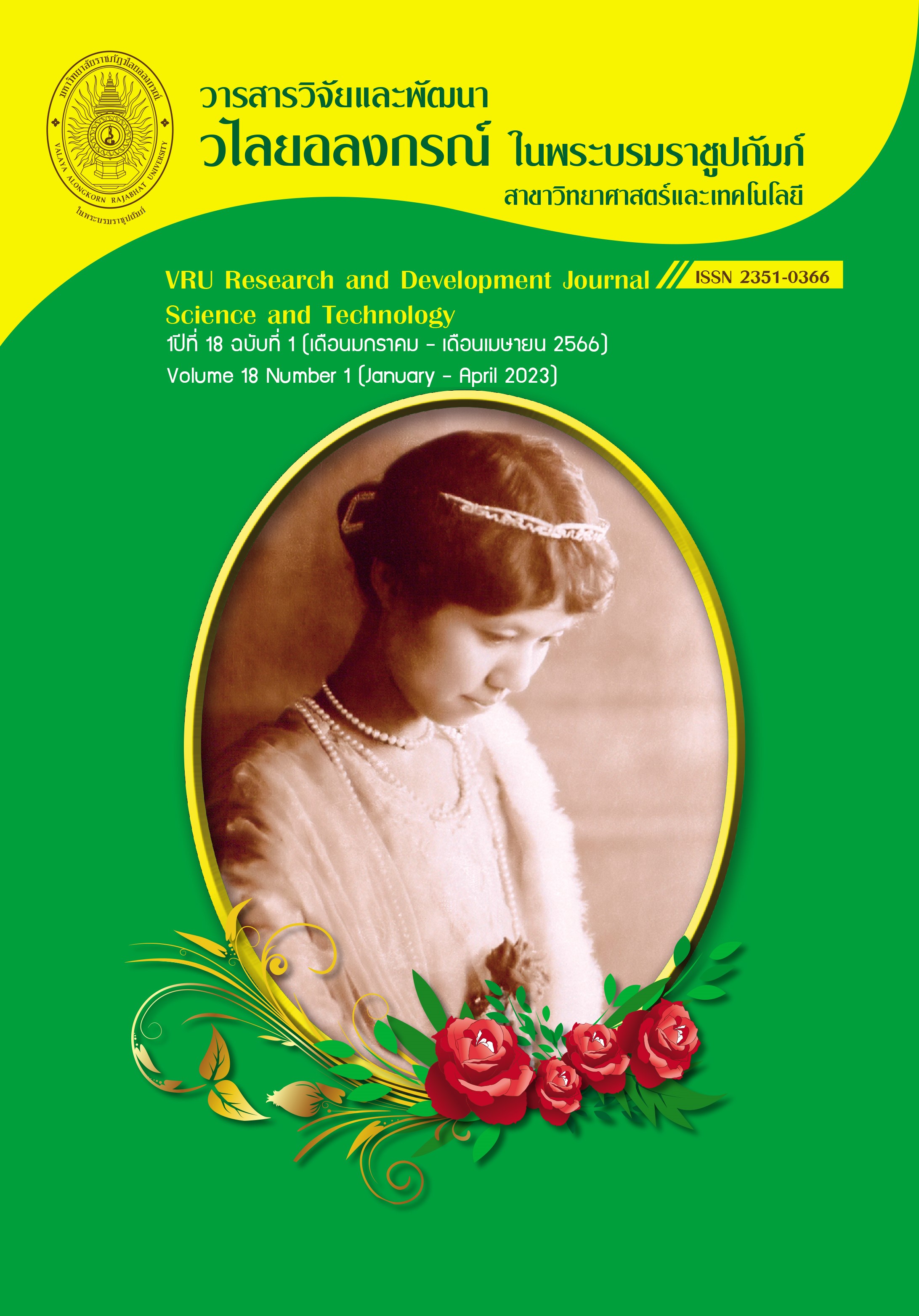THE EFFECT OF MICROBIOLOGICAL AIR QUALITY ON THE BIOLOGICAL DETERIORATION OF THE CHAI-MONGKHON PAGODA AT WAT YAI CHAI-MONGKHON IN PHRA NAKHON SI AYUTTHAYA PROVINCE
Main Article Content
Abstract
The aim of this research was to study the effects of the microbiological quality of the air in the archeological site of Chai Mongkhon pagoda at Wat Yai Chai Mongkhon in Phra Nakhon Si Ayutthaya province on biodeterioration. For this purpose, the air quality was investigated by scanning electron microscope (SEM), gravitational plate method, and the total bacterial count. The effects of pure actinomycetes isolated from air by starch-casein agar (SCA) and actinomycete isolation agar (AIA) on biodeterioration, the pH of the culture broth, and pigment secretion ability were studied. The results showed that the various shape particles from the air samples on the filter membrane were detected by electron microscope. In addition, the indoor microbiological air quality was compared with the outdoor air quality by the gravity plate method. The result showed that the outdoor samples had a higher number of microorganisms than the indoor air samples except for the samples which were collected in July and April. A total of 65 isolates of actinomycetes were isolated from the air samples.All 65 pure actinomycetes produced substances that affected the pH of the culture broth. Sixty-four isolates secreted an alkaline substance, and only 1 isolate secreted an acidic substance. Fifty-six percent of the isolates were able to secrete pigment from the cell that was brown, pink, yellow, orange, purple, and green, respectively (44%, 33%, 11%, 6%, 3%, and 3%).
Downloads
Article Details
ลิขสิทธิ์บทความวิจัยที่ได้รับการตีพิมพ์เผยแพร่ในวารสารวิจัยและพัฒนา วไลยอลงกรณ์ ในพระบรมราชูปถัมภ์ ถือเป็นกรรมสิทธิ์ของสถาบันวิจัยและพัฒนา มหาวิทยาลัยราชภัฏวไลยอลงกรณ์ ในพระบรมราชูปถัมภ์ ห้ามนำข้อความทั้งหมดหรือบางส่วนไปพิมพ์ซ้ำ เว้นแต่จะได้รับอนุญาตจากมหาวิทยาลัยเป็นลายลักษณ์อักษร
ความรับผิดชอบ เนื้อหาต้นฉบับที่ปรากฏในวารสารวิจัยและพัฒนา วไลยอลงกรณ์ ในพระบรมราชูปถัมภ์ เป็นความรับผิดชอบของผู้นิพนธ์บทความหรือผู้เขียนเอง ทั้งนี้ไม่รวมความผิดพลาดอันเกิดจากเทคนิคการพิมพ์
References
ปราโมช เชี่ยวชาญ. (2554). การเก็บตัวอย่างมลพิษอากาศ: ตอนที่ 1. สืบค้นจาก https://www.stou. ac.th /schools/shs/booklet/book543/sanitation.html
พรพรรณ รัตนสัจจะ, และ ดวงหทัย สิงห์คะ. (2560). ผลกระทบของจุลินทรีย์ต่อโบราณสถาน. วารสารวิทยาศาสตร์และเทคโนโลยี มทร.สุวรรณภูมิ, 1(2), 27-35.
สุจิตกัลยา มฤครัฐอินแปลง. (2558). ความหลากหลายของแอคติโตแบคทีเรียที่มีผลต่อการเสื่อมสภาพทางชีววิทยาของวัดราชบูรณะจังหวัดพระนครศรีอยุธยา. วารสารวิทยาศาสตร์ คณะวิทยาศาสตร์และเทคโนโลยี มหาวิทยาลัยราชภัฏพิบูลสงคราม, 16(2), 300-311.
สุจิตกัลยา มฤครัฐอินแปลง. (2560a). การแยกและศึกษาสมบัติบางประการของแอคติโนแบคทีเรียจากโบราณสถานในอุทยานประวัติศาสตร์กำแพงเพชรที่ส่งผลกระทบต่อการเสื่อมสภาพทางชีววิทยา. วารสารวิทยาศาสตร์ มศว, 33(2), 51-69.
สุจิตกัลยา มฤครัฐอินแปลง. (2560b). การคัดแยกและศึกษาสมบัติบางประการของแอคติโนแบคทีเรียที่มีผลต่อการเสื่อมสภาพทางชีววิทยาของโบราณสถานในอุทยานประวัติศาสตร์สุโขทัย วารสารวิจัยและพัฒนา วไลยอลงกรณ์ ในพระบรมราชูปถัมภ์ สาขาวิทยาศาสตร์และเทคโนโลยี, 12(1), 107-117.
Abdulla, H., May, E., Bahgat, M., & Dewedar, A. (2008). Characterization of actinomycetes isolation from ancient stone and their potential for deterioration. Polish Journal of Microbiology, 57(3), 213-220.
Bartoli, F., Municchia, A. C., Futagami, Y., Kashiwadani, H., & Moon, K. H. (2014). Biological colonization patterns on the ruins of Angkor temples (Cambodia) in the biodeterioration vs bioprotection debate. International Biodeterioration & Degradation, 96, 157-165.
Bayram, S. (2021). Production, purification, and characterization of Streptomyces sp. strain MPPS2 extracellular pyomelanin pigment. Archives of microbiology, 203(7), 4419–4426.
Borrego, S., Guiamet, P., Gomez de Saravia, S., Batistini, P., Garcia, M., Lavin, P., & Perdomo, L. (2010). The quality of air at archives and biodeterioration of photographs. International Biodeterioration & Biodegradation, 64, 139-145.
Bugajny, A., Knopkiewicz, M., Piotraszewska Pajak, A., Sekulska-Stryjakowska, M., Stach, A., & Filipiak, M. (2005). On the microbiological quality of the outdoor air in Poznan, Poland. Polish Journal of Environmental Studies, 14(3), 287-293.
De Leo F., Iero A., Zammit G., & Urzì C. (2012). Chemoorganotrophic bacteria isolated from biodeteriorated surfaces in cave and catacombs. International Journal of Speleology, 41(2), 125-136.
El-Naggar, N. E. A., & El-Ewasy, S. M. (2017). Bioproduction, characterization, anticancer and antioxidant activities of extracellular melanin pigment produced by newly isolated microbial cell factories Streptomyces glaucescens NEAE-H. Scientific reports, 7(1), 42129.
Farda, B., Djebaili, R., Vaccarelli, I., Del Gallo, M., & Pellegrini, M. (2022). Actinomycetes from Caves: An overview of their diversity, biotechnological properties, and insights for their use in soil environments. Retrieved from https://www.ncbi.nlm.nih.gov/pmc/ articles/PMC8875103/pdf/microorganisms-10-00453.pdf
Jeffrey, L. S. H., & Azrizal, M. R. (2007). Screening for cellulose activities in actinomycetes isolated from different location of Peninsular Malaysia. Journal of Tropical Agriculture and Food Science, 35(1), 153-157.
Johnson, H. M. (1965). Concerted structure: causes of deterioration and preventive measure. Deterioration, Maintenance and Repair of Structure. New York: MacGrew-Hill
Kheiralla, Z. H., Hewedy, M. A., Mohammed, H. R., & Drawesh, O. M. (2016). Isolation of Pigment Producing Actinomycetes from Rhizosphere Soil and Application It in Textiles Dyeing. Retrieved from https://www.rjpbcs.com/pdf/2016_7(5)/[270].pdf
Kim, M. J., Shin, H. K., Choi, Y., Kim, G., & Kim, G. H. (2016). An aero mycological study of various wooden cultural heritages in Korea. Journal of Cultural Heritage, 17, 123-130.
Kumer, R., & Kumer, A. V. (1999). Biodeterioration of stone in tropical environment: an overview. The Getty Conservation institute, 1-9.
Li, J., Deng, M., Gao, L., Yen, S, Katayama, Y., & Gu, J. D. (2021). The active microbes and biochemical processes contributing to deterioration of Angkor sandstone monuments under the tropical climate in Cambodia – A review. Journal of cultural heritage, 47, 218-226.
Nakaew, N., Pathom-aree, W., & Lumyong, S. (2009). Genetic diversity of rare Actinomycetes from Thai cave and their possible use as new bioactive compounds. Actinomycetologica, 23(2), 21-26.
Parmar, R.S., Singh, C., & Kumar, A. (2017). Optimization of cultural parameters for pigment production from Streptomyces flavofuscus ARITM02, isolated from rhizosphere soil. International Journal of Current Microbiology and Applied Sciences, 6(2), 961-966.
Rajendran, R., & Nisy, P. (2012). A study on the indoor and outdoor microflora associated with the biodeterioration of mural painting at Sekharaipuram Visnu temple, Adakkaputhur, Palakkad, Kerala, India. International Journal of Environmental Sciences and Research, 1(4), 104-108.
Samuel, F., & Bahilu, G. (2015). Microbiological assessment of indoor air of teaching hospital wards: a case of Jimma university specialized hospital. Ethiop Journal Health Science, 25(2), 117-122.
Tomassetti, M. C., Clrigliano, A., Arrighi, C., Negri, R., Mura, F., Maneschi, M. L., Gentili, M. D., Stirpe, M., Mazzoni, C., & Rinaldi, T. (2017). A role for microbial selection in frescoes deterioration in Tomba degli Scudi in Tarquinia, Italy. Scientific report, 7, 6027-6035.

